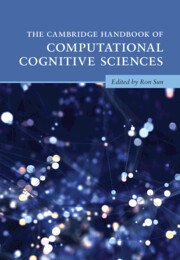Book contents
- The Cambridge Handbook of Computational Cognitive Sciences
- Cambridge Handbooks in Psychology
- The Cambridge Handbook of Computational Cognitive Sciences
- Copyright page
- Contents
- Preface
- Contributors
- Part I Introduction
- Part II Cognitive Modeling Paradigms
- Part III Computational Modeling of Basic Cognitive Functionalities
- Part IV Computational Modeling in Various Cognitive Fields
- Part V General Discussion
- 36 Model Validation, Comparison, and Selection
- 37 Philosophical Issues in Computational Cognitive Sciences
- 38 An Evaluation of Computational Modeling in Cognitive Sciences
- Index
- References
37 - Philosophical Issues in Computational Cognitive Sciences
from Part V - General Discussion
Published online by Cambridge University Press: 21 April 2023
- The Cambridge Handbook of Computational Cognitive Sciences
- Cambridge Handbooks in Psychology
- The Cambridge Handbook of Computational Cognitive Sciences
- Copyright page
- Contents
- Preface
- Contributors
- Part I Introduction
- Part II Cognitive Modeling Paradigms
- Part III Computational Modeling of Basic Cognitive Functionalities
- Part IV Computational Modeling in Various Cognitive Fields
- Part V General Discussion
- 36 Model Validation, Comparison, and Selection
- 37 Philosophical Issues in Computational Cognitive Sciences
- 38 An Evaluation of Computational Modeling in Cognitive Sciences
- Index
- References
Summary
What counts as a philosophical issue in computational cognitive science? This chapter briefly reviews possible answers before focusing on a specific subset of philosophical issues. These surround challenges that have been raised by philosophers regarding the scope of computational models of cognition. The arguments suggest that there are aspects of human cognition that may, for various reasons, resist explanation or description in terms of computation. The primary targets of these “no go” arguments have been semantic content, phenomenal consciousness, and central reasoning. This chapter reviews the arguments and considers possible replies. It concludes by highlighting the differences between the arguments, their limitations, and how they might contribute to the wider project of estimating the value of ongoing research programs in computational cognitive science.
- Type
- Chapter
- Information
- The Cambridge Handbook of Computational Cognitive Sciences , pp. 1201 - 1227Publisher: Cambridge University PressPrint publication year: 2023

